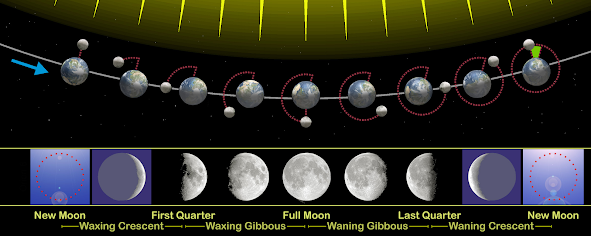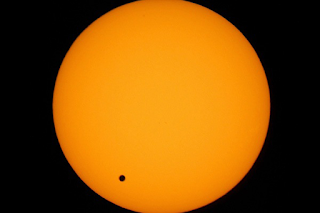Venus — A Beacon of Light
Do you wonder why Venus is so bright right now?
The exact reason why Venus has been dominating the western sky after sunset and will continue to do so for a few more weeks is that it is at its greatest eastern elongation. I know this is going to raise a lot of eyebrows. And likewise so. We do not come to this world preloaded with all the knowledge. As far as astronomy is concerned, you begin by looking up, learning a new word every day, and then one day discover something unique.
Okay. Enough beating around the bush. What is this elongation anyway? Let us start with the following figure.
 |
| The relative position of planets and their distance with respect to the Sun Image Credits: Source Public Domain, via Wikimedia Commons. |
You are looking at the heliocentric model of the solar system, put forward by Nicolaus Copernicus in 1543. Taking Earth as the reference point, Mercury and Venus fall into the category of inferior planets as they lie closer to the Sun than Earth. That is, their orbits lie within Earth's. In numbers, Mercury orbits the Sun at an average distance of 57.9 million km from the Sun, Venus lies at 108.2 million km, while our placid little island, Earth, sits snugly at 149.6 million km from the Sun. Mars, Jupiter, Saturn, Uranus, Neptune, and Pluto are the superior planets. Superior because their orbits lie beyond Earth's, ranging from 227.9 million km for Mars to 5.9 billion km for Pluto. Since Pluto is not a plant anymore, Neptune becomes the farthest member at 4.5 billion km from the Sun.
 |
| Exaggerated animation of orbital motions of Mercury to Mars. Credits: Wikipedia (original) CC BY-SA 4.0 |
 |
| Exaggerated animation of orbital motions of Jupiter to Neptune. Credits: Wikipedia (original) CC BY-SA 4.0 |
 |
| Phases of the Moon. Image Credits: Public Domain, via Wikimedia Commons (link to source). CC BY-SA 3.0 |
Inferior conjunction refers to a specific position where the elongation angle, i.e., the angular separation between Venus and the Sun with respect to Earth, becomes 0°. However, exact 0° elongation means Venus lies perfectly on the line of sight from Earth to the Sun, much like during a solar eclipse when the Moon lodges itself between the Sun and Earth and eclipses the former. For Venus, when it passes between the Sun and Earth, we do not see an eclipse for obvious reasons. Instead, we witness a spectacular astronomical event known as a transit.
Just as solar eclipses do not occur every 29 days due to the mismatch of the orbital planes of the Earth and Moon, transits are also infrequent. Except when it does, we get to see Venus crisscrossing our line of sight, a tiny dark dot racing across the illuminated backdrop of the Sun. This is how it looks.
 |
| Venus Transit June 2012. Captured from Delhi, India. Image Credits: Public Domain, via Wikimedia Commons. Wikipedia page link. Attribution: Ministry of Earth Science. |
Post inferior conjunction, Venus' elongation gradually increases as the planet moves west of the Sun. At its greatest western elongation, Venus, once again, attains its maximum angular separation from the Sun and appears as a morning star shining bright for more than an hour before sunrise. This continues for a few weeks. With each passing day, Venus waxes from ~1% illumination at inferior conjunction to ~50% at maximum elongation(s). From western elongation, Venus continues waxing while its angular separation comes down progressively. But this time, Earth's twin sister moves behind the Sun so as to reach superior conjunction. If you could point a telescope with appropriate filters that significantly reduce the glare of the Sun, you would see Venus either sliding behind the Solar disc or passing extremely close to the Sun but from behind, unlike at inferior conjunction where the planet passes in front of the Sun. The whole pattern — superior conjunction to eastern elongation (evening star) — eastern elongation to inferior conjunction — inferior conjunction to western elongation (morning star) — and finally — western elongation to superior conjunction — repeats itself over and over again.
If you log on to any astronomy software like Stellarium, you can begin to track Venus and whatever celestial object you fancy with just a click. Starting with the preset positioning, I give you a list of future events.
- 04/06/2023 (dd/mm/yyyy). Greatest Eastern Elongation. Elongation of 45° (E45° in ecliptic longitude). 49.8% Illuminated. Waning Gibbous Phase. Visible on the western horizon after sunset. Heading towards Inferior Conjunction.
.png) |
| Waning 50% illumination at maximum eastern elongation. |
- 13/08/2023. Inferior Conjunction. Elongation of 7° (0°E in ecliptic longitude). 0.9% Illuminated. Waning Crescent Phase. Lost to the glare of the daytime Sun. Heading towards greatest western elongation.
.png) |
| A thin crescent. |
- 24/10/2023. Greatest Western Elongation. Elongation of 46° (W46° in ecliptic longitude). 50.7% Illuminated. Waxing Gibbous Phase. Visible on the eastern horizon early morning before sunrise. Heading towards superior conjunction.
.png) |
| Waxing 50% illumination at maximum western elongation. |
- 04/06/2024. Superior Conjunction. Elongation of 180° (W0° in ecliptic longitude). 100% Illuminated. Full Phase. Lost to the glare of the daytime Sun. Heading towards greatest eastern elongation.
.png) |
| Before disappearing behind the Sun. |
.png) |
| Behind the Sun. |
.png) |
| Reappearance. |
- 10/01/2025. Greatest Eastern Elongation. 586 days since 04/06/2023.
- 23/03/2025. Inferior Conjunction. 588 days since 13/08/2023.
- 31/05/2025. Greatest Western Elongation. 585 days since 24/10/2023.
- 06/01/2026. Superior Conjunction. 581 days since 04/06/2024.
To summarize everything, near inferior conjunction, while Venus appears closest to the Sun, it remains lost in daylight, rising and setting with the Sun. Past inferior conjunction, as its elongation increases, it migrates away from the Sun. At maximum separation, 45°~47°, and at waxing 50% illumination, it appears as a bright evening star in the morning twilight sky. Crossing western elongation, it continues waxing, but its angular separation decreases as it comes to pass behind the Sun. In ecliptic longitude, at superior conjunction, Venus' elongation touches 180°, and thence, the planet is fully illuminated. Being situated behind the Sun, once again, it rises and sets with the Sun, and as a result, we lose it to daytime glare. From superior conjunction, its elongation increases and becomes maximum at eastern elongation when it regains its status of an evening star. From superior conjunction, its illumination wanes to 50% at eastern elongation to almost 1% as it reaches inferior conjunction. Then, the cycle repeats.
As inferior planets, Venus and Mercury, unlike Mars or Jupiter, appear very close to the Sun. If you begin to follow them, you will never, as in ever, see Venus right over your head (zenith) at late hours after sundown. You will see all of the superior planets, Mars to Neptune (for Uranus and Neptune, you need a decent pair of binoculars plus low levels of light pollution) higher up the zenith, sometimes rising from the east hours after sunset, completely at opposite poles of the celestial dome. Venus and Mercury rise and set with the Sun in tandem, as if connected by a tether. Only at maximum elongation does Venus or Mercury get to stay the farthest from the Sun — 45°~47° for Venus and 18°~28° for Mercury, which gives them sufficient time to make their mark in the progressively darkening sky at evening twilight before the Sun takes them below the horizon.
You still have around a month to enjoy Venus shining as a beacon of light. Maybe She's asking you out. If you want my advice, go! Go out. Look up. There are more worlds out there than grains of sand on Earth.


Comments
Post a Comment